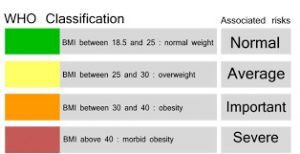Body mass index (BMI) is a good way to assess your body weight relative to height. This method is an indirect measure of body composition because it correlates highly with body fat in most people. Having a BMI above 25 can indicate a high risk of developing cardiovascular disease, diabetes, strokes, certain cancers, and osteoarthritis.
BMI Categories from the National Center for Health Statistics:
- Adult (18 and older) BMI values less than 18.5 are considered underweight.
- Adult BMI values from 18.5 to 24.9 are healthy.
- Overweight is defined as a BMI of 25.0 to less than 30.0. Adults with a BMI in this range are at greater risk of developing heart disease.
- Obesity is defined as a BMI of 30.0 or greater for adults over the age of 18. People with a BMI in this range are at greater risk of cardiovascular disease, strokes, diabetes, and joint problems.
- Extreme obesity is defined as a BMI of 40 or greater.
- Obesity for children aged 10 years is defined as a BMI of 24.11 for females and 24.00 for males.
- Obesity for children aged 15 years is defined as a BMI of 29.11 for females and 28.30 for males
BMI Calculator
Body Mass Index, or BMI, is a person’s weight in kilograms divided by the square of his/her height in meters. The National Institute of Health (NIH) has now defined BMI to be the deciding parameter to know if you are underweight, normal weight, overweight or obese.
Body Mass Index, or BMI, is a key index that relates to one’s height and weight. It is a person’s weight in kilograms divided by the square of his/her height in meters. The National Institute of Health (NIH) has now defined BMI to be the deciding parameter to know if you are underweight, normal weight, overweight or obese. Hence, knowing your BMI is a very important factor in maintaining a healthy body and an optimum fitness level.
A healthy BMI can also help you keep diseases like heart problem, type 2 diabetes and hypertension at bay. A normal BMI is an indicator of being at your ideal weight. BMI is basically a quantified measure for the amount of tissue mass, that is muscles, fat and bones,ofan individual.
However, if you are an athlete or an overall active person, your body weight may be high not because of fat but because of muscle. Muscle is denser than fat and abundance of muscle means more weight and hence, higher BMI. But in such a situation, it is not unhealthy because it doesn’t have the associated health risks which a high BMI reading carries.
How is BMI calculated?
BMI is calculated by dividing a person’s weight in kilograms by the square of his/her height in meters. For example, if your weight is 60 kilograms and your height is 5 feet 3 inches, your BMI will be calculated as follows:
60 / 2.61 (1.6 * 1.6)
(5 feet 3 inches is approximately 1.6 meters)
This gives us a BMI reading at 22.9.
Why is BMI calculation important for your health?
The National Institute of Health (NIH) has now defined BMI to be the deciding parameter to know if you are underweight, normal weight, overweight or obese. If you do not fall in the category of normal weight, your health is at risk. Let’s say your BMI is 17.5. This means that you are underweight. Being underweight makes you more prone to diseases because it signifies that your body’s immunity is weak. You can even get osteoporosis in later stages of life or be anaemic.
However, if you are overweight, obese or severely obese, your chances of developing various diseases increase with the increase in your BMI number. You get more prone to diseases such as high blood pressure, type 2 diabetes, high cholesterol, coronary artery disease, stroke, among many others.
What is the average BMI value for children and adults?
In children, BMI is calculated in the same way as adults but the healthy and unhealthy ranges are determined in a different way. We do not have fixed values to determine healthy and at-risk thresholds in children. Children’s BMI values are compared with other children of the same age and sex and a percentile is calculated.
If the BMI value is below the 5th percentile for children, they are considered underweight. If the BMI value is over 95th percentile value, they are considered obese. A value within 85th and 95th percentile is considered overweight and from 5th to 85th percentile, the value is considered as normal.
When to see a doctor?
 Ideally, if your BMI belongs to any category other than normal, you should get yourself tested every once in six months or a year at the maximum. However, the farther your BMI is from the normal range, that is 18.5 to 25, the more risk you are at. If you are severely underweight or even at the beginning threshold of obesity, you must see a doctor immediately.
Ideally, if your BMI belongs to any category other than normal, you should get yourself tested every once in six months or a year at the maximum. However, the farther your BMI is from the normal range, that is 18.5 to 25, the more risk you are at. If you are severely underweight or even at the beginning threshold of obesity, you must see a doctor immediately.
For the rest of the readings, it is difficult to tell the exact condition of your health because of the limiting extent of a BMI number. The above value only gives you an estimate that applies to everyone. They are non-personal and should not replace medical advice in any situation.


